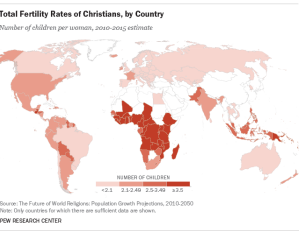
Pew Research Center has made demographic projections on what the future of Christianity could look like around the world by 2050.
In a report written by David Masci, Pew claimed that the global Christian population would continue its shift southward over the next four decades. While the overall share of Christians in the world is expected to remain flat, there will be dramatic swings, especially in the Christian populations of Europe and sub-Saharan Africa.
"Nearly half of the world's Christians already reside in Africa and the Latin America-Caribbean region," Masci wrote. "By 2050, according to the Pew Research study, those two regions will be home to more than six-in-ten of the world's followers of Jesus, with just a quarter of Christians living in Europe and North America."
Masci added that by 2050, nearly four-in-ten of the world's Christians are projected to live in sub-Saharan Africa. Previously, Christians made up 24 percent in the region back in 2010 and as little as 2 percent back in 1910.
"This was not always the case," Masci wrote. "In 1910, for instance, Europe was home to roughly two-thirds (66 percent) of the world's Christians, with North America a distant second with 15 percent."

Rev. Gift Moerane of the South African Council of Churches told Sanya Mansoor of Times Live that Christianity thrived in his nation because it was "a collaboration of culture and religion that can blend together and harmonize."
"Religious people don't only focus on reading the Bible and praying‚ but also using their faith to deal with social issues," Moreane said.
Moreane added that practicing Christianity has created "social cohesion," "a support system" and a "fertile ground for growth." He noted that in times of hardship, people in South Africa look to Christianity as a "cushion."
"When you don't have means for survival‚ the only way to sustain yourself is through prayer and belief‚" Moreane said.
Masci reported that five of the 10 largest Christian populations in the world will be in Africa. These countries included the Democratic Republic of Congo, Tanzania, Ethiopia and Uganda.
"By contrast, 35 years from now, the share of global Christians who call Europe home will have dropped to roughly 16 percent (from 26 percent in 2010)," Masci wrote. "In addition, only 10 percent of the world's Christians will be living in North America, down from 12 percent in 2010."
As for Christians living in the Asia-Pacific region, Pew noted that the rate, which currently hovers around 13 percent, is expected to remain the same by 2050. However, the estimate could change thanks to uncertainty from data collected in China.
"The biggest factor in determining the future global distribution of Christians is population growth, which in turn is driven by factors such as fertility rates," Masci wrote.
As for Christians in the United States, Pew Research reported that the U.S. will remain the country with the world's largest Christian population, which is estimated to be 262 million by 2050.







